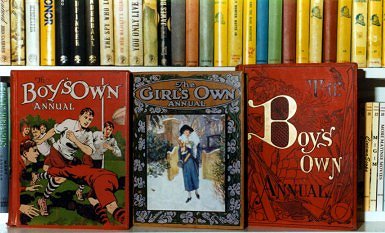| bc |
AUCTIONS
Purchased at auction in 1997. This article hasn't been revised since 2000 so is out of date! Buying books (among other things) at auction is an exciting, habit-forming and sometimes scary way of filling in the gaps on your shelves. Like many collectors, I'd never dream of buying a book through the mail. I find no great delight in acquiring a much-wanted volume in such a mundane manner. Give me the excitement of the hunt through mysterious little junk and charity shops, or the auction room. Jonathan Gash fired my enthusiasm through his 'Lovejoy' books and, of course, the wonderful TV series. I've picked up many interesting and, at times, exciting books, children's annuals, story papers and old magazines over the past five or so years I've been attending Sydney auctions. The following information should be useful to you wherever you live, as auction houses operate much the same way throughout the world. Two auctions I used to attend regularly in Sydney were those of Raffan and Kelaher (weekly ~ this is known as a bric-a-brac auction as it includes books, magazines and other printed ephemera among kitchen utensils, records and other small household items) and Lawsons (usually 6-weekly - this is a specialised book and print auction). R&K's auction starts at 9am each Monday so one needs to be up early. You can view Saturday mornings or before and during R&K's auction. If you don't wish to attend the actual auction, you fill in an absentee bid form: you nominate a maximum bid for the lot you want and the auctioneer will bid on your behalf, usually making the first bid at one half to two-thirds of your maximum limit. The quantity (and quality) of books on offer varies widely from week to week. Usually there is a special book table which will contain books in lots of one to maybe 10 books, plus cartons spread around the rest of the room. I've now (hopefully) conquered the urge to bid on, for example, 5 cartons of a hundred books in order to pick up one Biggles book! To register as a bidder at R&K, you simply fill in a form with your name and address, etc., and you are given a piece of paper upon which your initials are displayed in large texta. A bid is made by holding your hand/pen/almost anything in the air but don't leave it there or you may find yourself well over your limit. Yes, always mentally set yourself a limit and never, NEVER exceed it. If you succeed in having the lot knocked down to you, hold the piece of paper, right way up if you please (!) so that the auctioneer can clearly read your initials, which he will do out loud, in order to avoid any misunderstandings. A few tips: if you have the chance, and once you've attended your first auction, introduce yourself to the auctioneer and ask he or she about the history of the auction house. From my own experiences, I can tell you that personal contact will often ensure things will go smoothly during any auction. Some vendors (sellers) bid on their own lots to force up the price and will buy back the lots if they're not happy with the levels reached. SO, that's why you must stick by your limit. Don't tell any other bidder what that limit is. Reports in the media on auctions often refer to 'off the wall' or phantom bids; if you're feeling paranoid you might want to stand where you can watch the rest of the room during an auction but this really isn't a problem at any of the events I frequent. You'll find after a while that others bidders will introduce themselves and You'll then have a chance to air your wants. I've made a number of friends, and contacts, through auctions and as a result have acquired literally hundreds of good books. After all, by selling to you, vendors will be saving themselves the 10% plus $1 a lot commission. This reminds me to mention that bidders have a buyers' commission (usually 10% but check with the auctioneer) added to their invoice. You'll be able to pay for and pick up your lots during the auction if you wish, once the auctioneer's sheets have been entered on the computer generally 25 lots past your last lot. Lawsons are more 'up-market' but the only real differences are the method of bidding and viewing times. You are given a card with a number, rather than your initials. Viewing is beforehand and not during the auction. Rather than walk around the room and have the lots pointed out to you by the auctioneer's assistant, you'll sit in an audience and simply have the lot numbers called out for bids: buy a catalogue to avoid making fatal mistakes! There is a good book published by Macmillan, The Auction Companion, by Daniel and Katharine Leab, which will answer most questions on the subject of auctions. Rapidly supplanting regular auctions were ONLINE AUCTIONS. You can find out all about this on our ONLINE AUCTION page, kindly compiled by: Back to Collecting Books & Magazines home page
|
bc |
